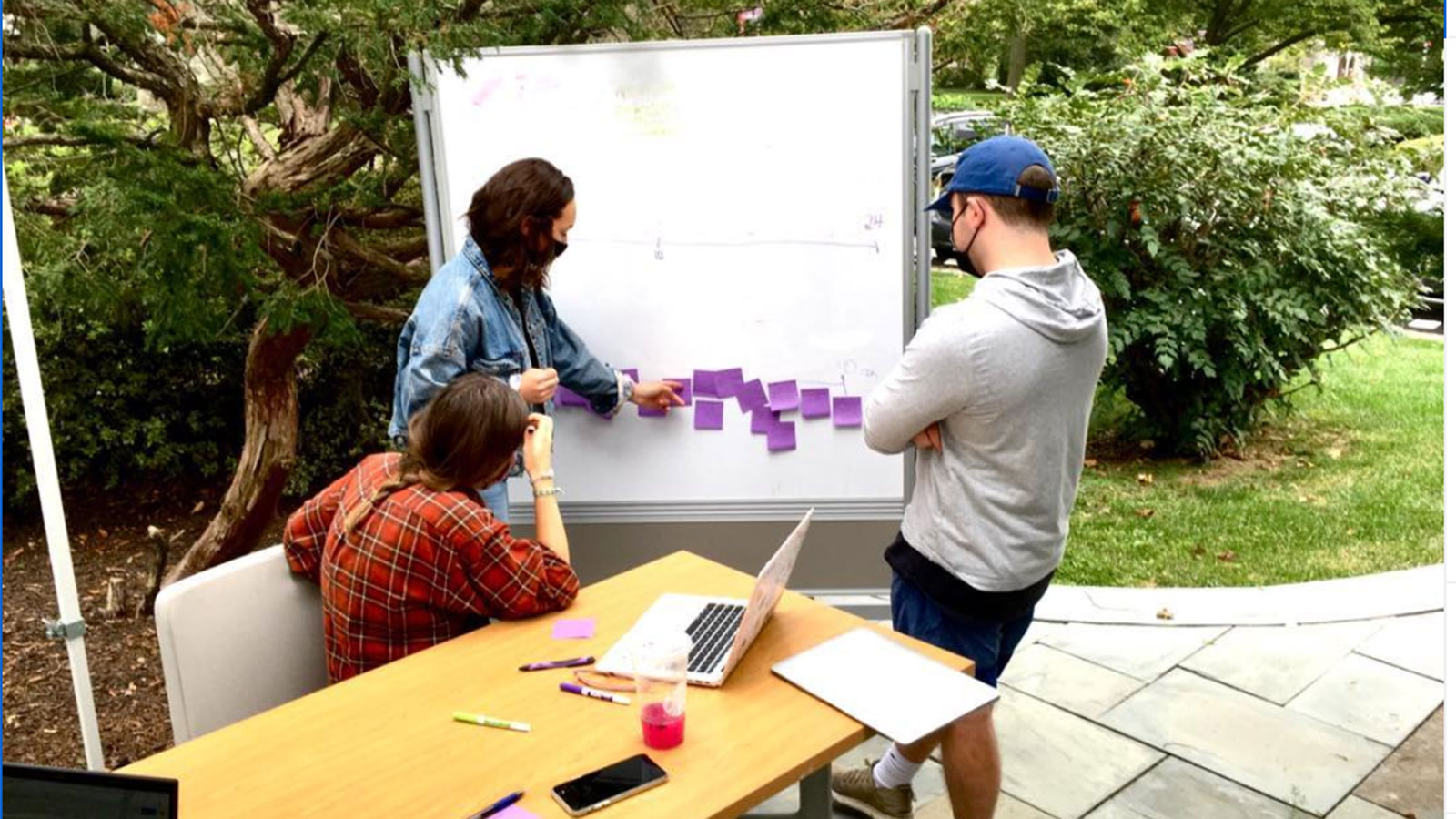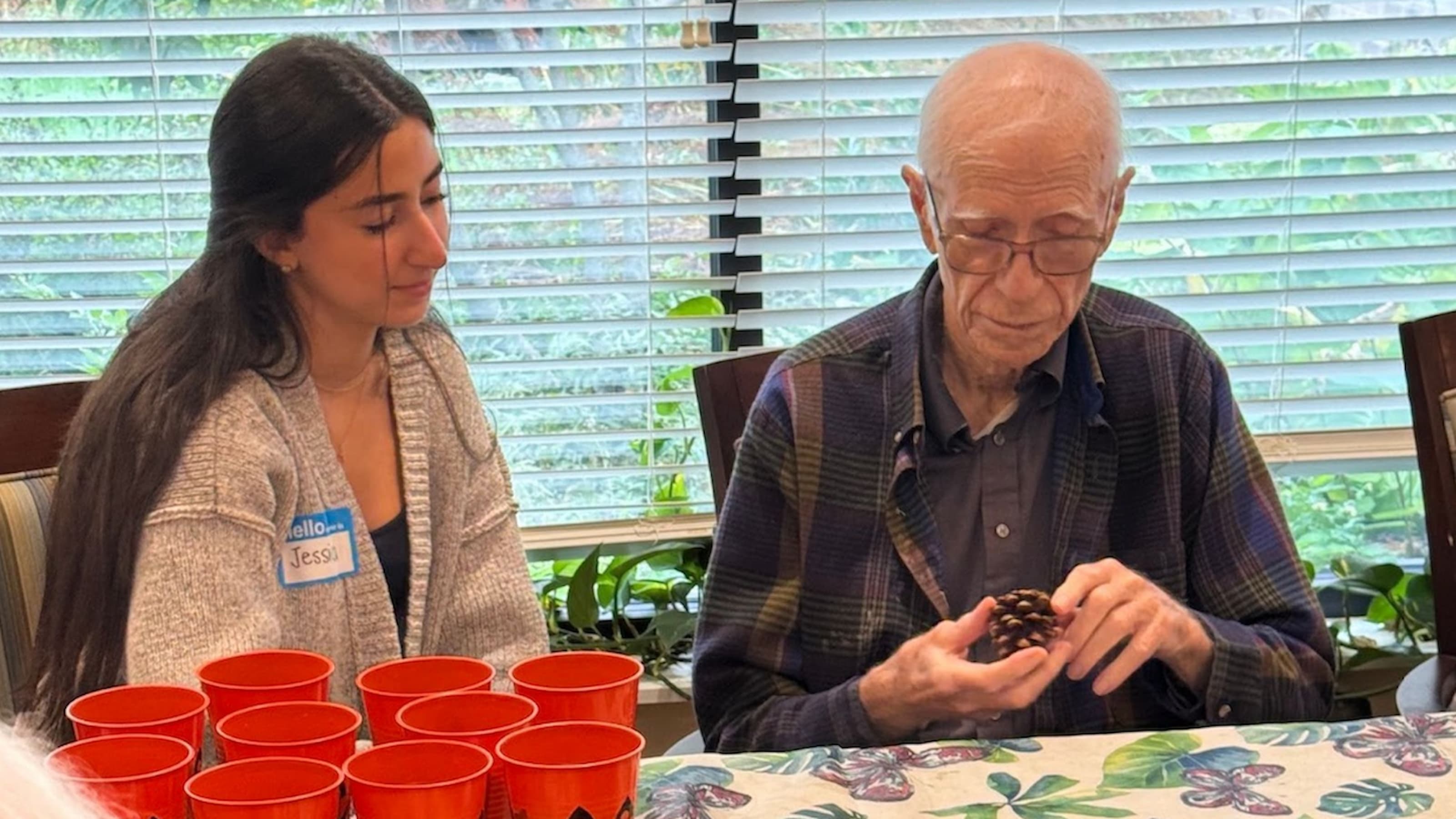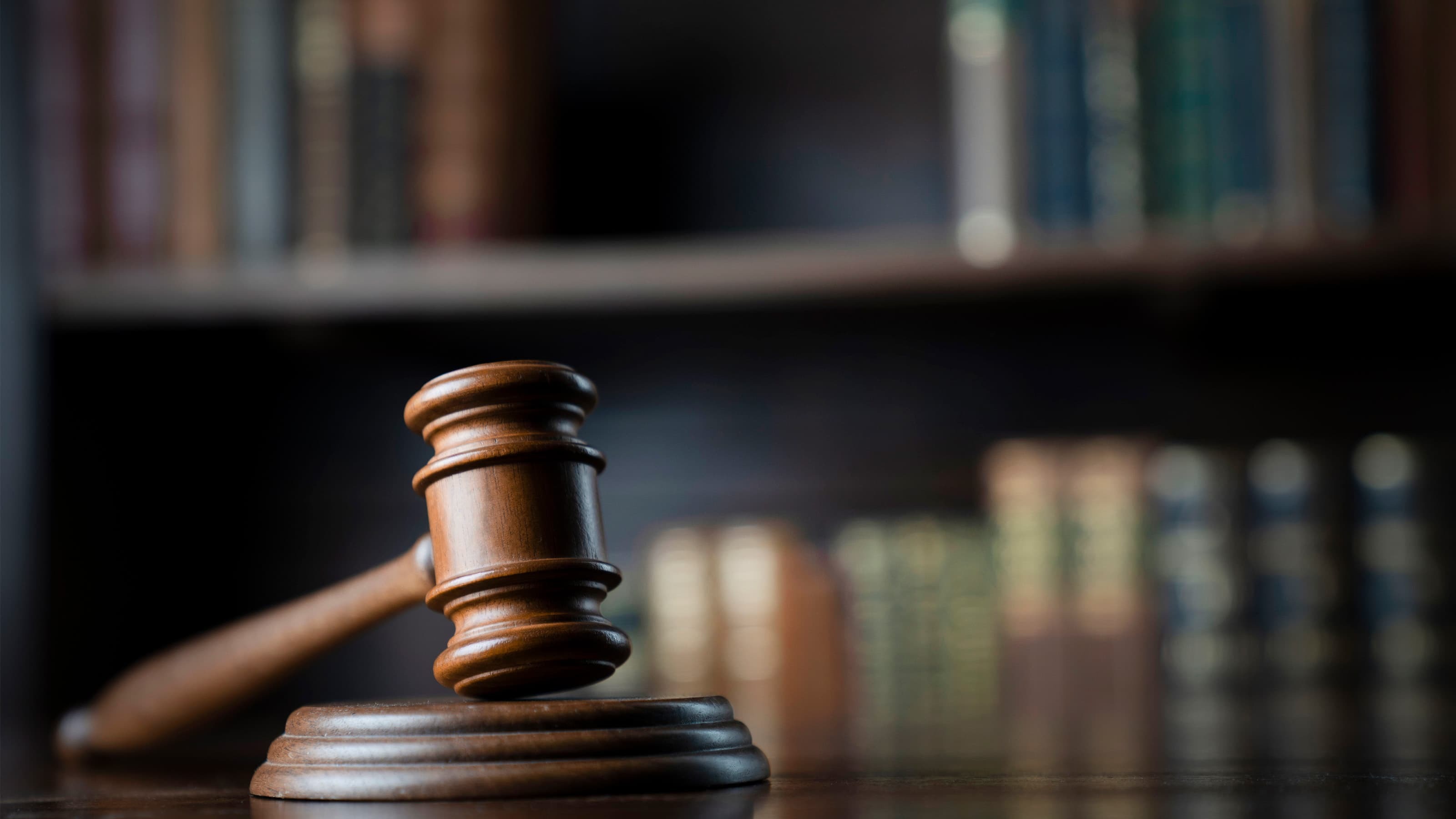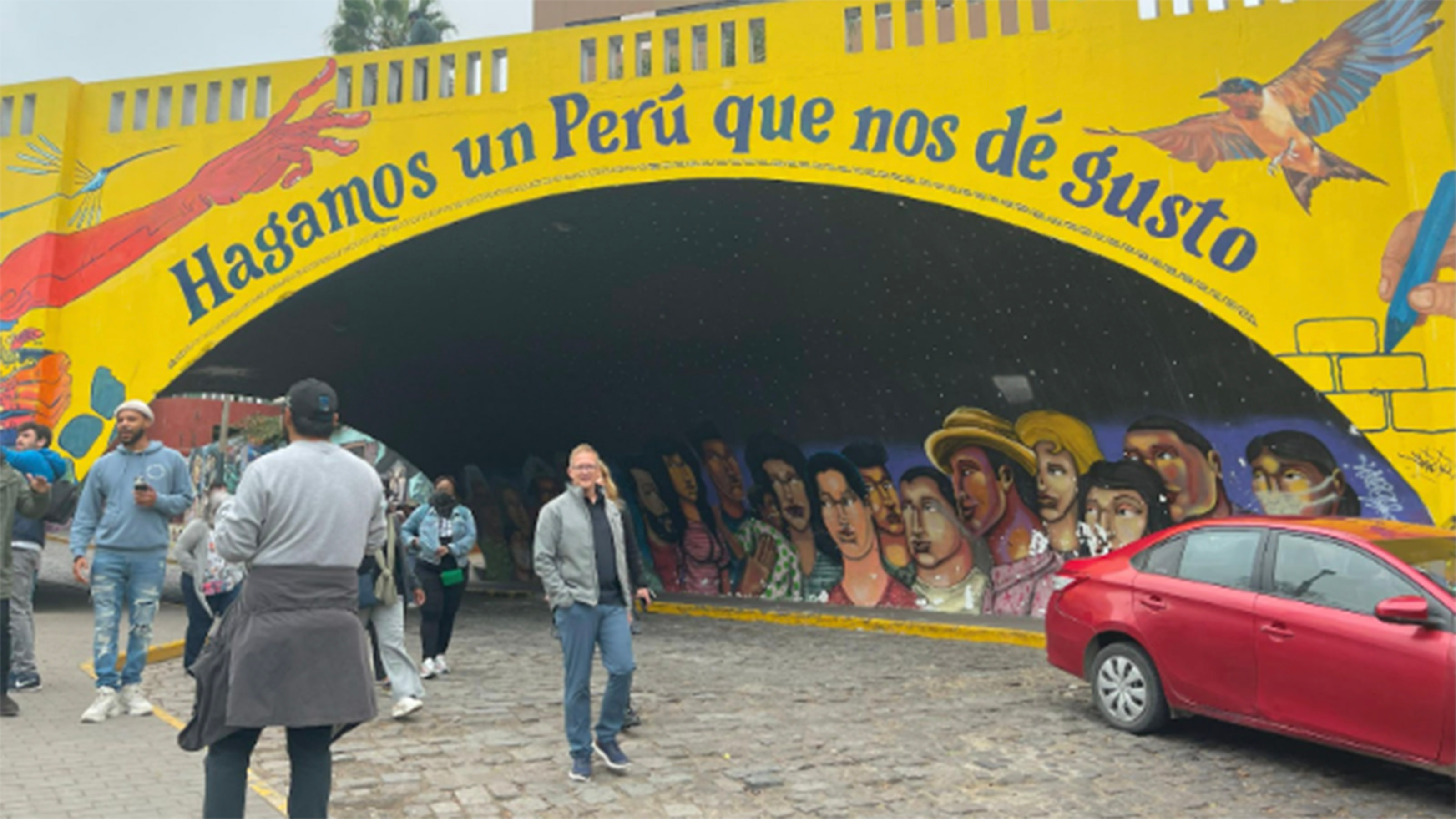Communications Professor Aims to Change the Crime Narrative Through Multimedia Storytelling
Mike Lyons, Ph.D., chair and associate professor of communication and media studies, and his students produced “On Both Sides,” a multimedia project featuring interviews with people who have lost loved ones to murder and incarceration for life. Lyons started the project with the Coalition to Abolish Death by Incarceration, a grassroots organization fighting to change harsh sentencing laws in Pennsylvania.
 Mike Lyons, Ph.D., (right) and CADBI members Lorraine Haw (left) and Kempis Songster (center) get ready to pitch the "On Both Sides" multimedia project at Good Pitch Local.
Mike Lyons, Ph.D., (right) and CADBI members Lorraine Haw (left) and Kempis Songster (center) get ready to pitch the "On Both Sides" multimedia project at Good Pitch Local.
- Mike Lyons, Ph.D., chair and associate professor of communication and media studies, started a multimedia project called “On Both Sides” with the Coalition to Abolish Death by Incarceration, a grassroots organization fighting to change harsh sentencing la
- The project features interviews with people who have lost loved ones to murder and incarceration for life and will be turned into a short documentary this year.
- Students in Lyons’ classes helped him conduct interviews and produce the videos, teaching them valuable lessons in documentary filmmaking and community storytelling.
Today, Pennsylvania has the second highest number of people serving life without parole in the U.S. Meanwhile, the City of Philadelphia has one of the highest homicide rates in the country.
But who are the individuals and families affected by these grim statistics? And how do communities harmed by mass incarceration and homicide find a way to heal?
These are some of the questions that Mike Lyons, Ph.D., chair and associate professor of communication and media studies at Saint Joseph’s University, and his students explore in “On Both Sides,” a multimedia project that features interviews with “dual victims” — people who have lost loved ones to murder and incarceration for life.
Lyons and the Philadelphia chapter of the Coalition to Abolish Death by Incarceration (CADBI), a grassroots organization fighting to change harsh sentencing laws in Pennsylvania, started the project to help change the narrative around crime and justice and spark legislative change.
“The goal was really to help people understand how violence and healing work from both sides by watching someone’s journey through it,” Lyons says.
CADBI member Lorraine Haw talks about what it was like losing a brother to homicide and a son to incarceration.
Exploring Social Justice Issues Through Multimedia Storytelling
The initial idea for On Both Sides came up in a few CADBI chapter meetings a couple of years ago, explains Lyons, a longtime volunteer for the organization. Many in the group have lost someone to violence and to prison, he says.
“The members would talk about how others don’t really understand how mass incarceration and homicide impact people, and the project kind of bubbled up out of those conversations,” Lyons says. “For example, how can somebody whose son is serving life without parole forgive someone who murdered their brother? Those stories add a new perspective on violence and healing.”
CADBI decided that video storytelling was the best way to share the stories with the public. Lyons, whose research interests and work focuses on the intersection of digital media and civic engagement — particularly around stories of crime and incarceration — helped conduct the interviews and record them.
In 2018, he got his students on board. “Community-engaged work is a big part of the communication and media studies department,” says Lyons, who recently received the 2021 Raymond A. Horn Scholar-Practitioner Award for leading community engagement scholarship initiatives at the University and greater Philadelphia area.
As part of the course, students met with people who are serving life without parole in Pennsylvania and documented their stories using audio, video and photography for The Redemption Project, another multimedia project Lyons started to increase public awareness about juveniles and adults serving mandatory life sentences in the state. Through that work, Lyons and his students found more people to interview for On Both Sides in addition to those he already met through CADBI.
Lyons had his students work on numerous tasks such as recording video and audio footage and post-production editing. He also opened up the project to students in his other courses, including his Digital Storytelling class.
When people watch the documentary, I hope they take away the nuances of healing and violence. We need to better understand how violence works and how we can heal as a community.”
Mike Lyons, Ph.D.
chair and associate professor of communication and media studiesDoing ‘Work that Helps, But Doesn’t Exploit’
Marcy Carini ’22, a criminal justice and communication and media studies double major, is one of many St. Joe’s students who worked on the On Both Sides project over the years.
In Lyons’ Digital Storytelling class last fall, Carini helped edit a video of a Philadelphia resident named Lorraine “Ms. DeeDee” Haw and her son, Phillip Ocampo. Haw is considered a dual victim — her brother was murdered over a gold chain in the late 1980s, while her son was sentenced to life in prison without parole in 1994 when he was 19 years old for being involved in a burglary during which his co-defendant shot and killed somebody.
Lyons had hours of recorded audio from his interviews with Haw and Ocampo, and Carini worked in a group to condense the audio down to five minutes and add b-roll and photos to tell their story.
Carini says she’s grateful for the experience she had because she not only learned about the technical aspects of filmmaking, such as using Adobe Premiere Pro to edit audio and video clips, but also how to convey important messages through film.
“We had to come up with a theme, which was forgiveness, and we wanted to show that people changed. We wanted to humanize [Ocampo],” Carini says. “We also wanted to show that people are better than their worst days — what someone does on one day should not define who they are for the rest of their lives. It was also important for us to do work that helps but doesn’t exploit.”

Lyons says it was crucial for students to understand the fragility of the work they were doing. “We started drilling down into what it means for a predominantly white group of students to go into a predominantly non-white environment to hear from the most vulnerable people in the city,” he says.
So, in addition to researching mass incarceration and criminal justice reform and exploring different styles of documentary filmmaking, Lyons and his students had discussions about the dangers of “extractive storytelling” — taking stories from communities rather than collaborating with them.
“It’s not just about sitting somebody down, putting a camera in their face and pulling their story out of them,” Lyons says. “You have to establish relationships with people and invest in them.”
Lyons says he’s excited for people to see the end product; the project is in the process of being turned into a short documentary, which Lyons submitted to Good Pitch Local, a grassroots initiative that helps activists and organizers tell important stories in their communities through digital media, and received funding to hire a filmmaker. Amistad Law Project, a public interest law firm with a mission to end mass incarceration in Pennsylvania, will help advertise the documentary once it’s finished and organize screenings in the city and the state capitol in Harrisburg.
“When people watch the documentary, I hope they take away the nuances of healing and violence. We need to better understand how violence works and how we can heal as a community,” Lyons says. “The current legal system does not provide this opportunity, so we also want to get this in front of legislators and help them understand how they can change this.”



